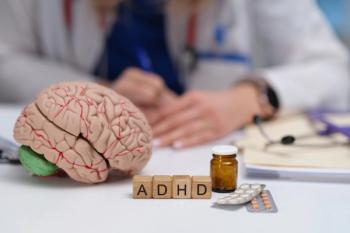
Boy With Extraordinarily High Blood Lead Levels
A 9-year-old asymptomatic boy was referred to our tertiary care facility with a blood lead level (BLL) of 59 ?g/dL. A diagnosis of attention deficit hyperactivity disorder, which was managed with amphetamine/dextroamphetamine, had been made when the patient was 6 years old.
A 9-year-old asymptomatic boy was referred to our tertiary care facility with a blood lead level (BLL) of 59 ?g/dL. A diagnosis of attention deficit hyperactivity disorder, which was managed with amphetamine/dextroamphetamine, had been made when the patient was 6 years old.
Other than the patient's abnormal eating habits, a review of systems was negative. According to his mother, the child ate "anything and everything- including refrigerator magnets!" Results of a physical examination were unremarkable. The complete blood cell count was normal, as was the zinc protoporphyrin level.
An abdominal radiograph (Figure 1) revealed multiple radiopaque specks throughout the colon and moderate stool retention. The patient was hospitalized for bowel clean-out and initiation of chelation therapy with succimer (meso-2,3-dimercaptosuccinic acid [DMSA]). Inspection of his stool revealed parts of refrigerator magnets, string, paper, labels, pigments of various colors, pencil points, and other unidentifiable particles (Figure 2). The exact source of lead was not determined- even after an extensive environmental inspection.
Figure 1 - This abdominal radiograph reveals multiple radiopaque foci in the colon that could represent lead-containing or other radiopaque material.
Figure 2 - These items were recovered from the stool of a child with pica
PICA AND LEAD INGESTION
Pica is the unusual phenomenon of compulsive ingestion of nonfood substances. Normally, children in the first 2 to 3 years of life explore objects in the environment with their mouths. When older persons ingest non-food substances, the habit is called pica.
Paper, clay, and dirt are a few of the more common non-food substances ingested, along with the chewing of ice (pagophagia). Pica may signal the presence of an underlying condition, including developmental and cognitive disorders (mental retardation, autism, dementia, delirium), psychiatric disorders (depression, schizophrenia, obsessive- compulsive disorder), and nutritional deficiencies (iron or zinc deficiency). It may be symptomatic of celiac disease, child neglect or inadequate supervision, or pregnancy. In some of these conditions, it is unknown whether pica is the cause or the effect.
The known potential consequences of pica are formation of a gastric bezoar,1 intestinal obstruction, 2 parasitic infection, and an elevated blood lead level.3 The normal mouthing of objects in early toddlerhood and pica are risk factors for elevated BLLs (in excess of 10 ?g/dL).3,4 In the United States, the main sources of lead are paint (mainly in homes built before the late 1970s), dust, and soil.4 Although adverse effects may result from a BLL lower than 10 ?g/dL, the American Academy of Pediatrics (AAP) and the CDC consider a BLL of 10 ?g/dL or greater as the threshold for concern.4
An elevated BLL can be confirmed with a single venous blood specimen or with any combination of 2 capillary and/or unknown blood specimens drawn within 12 weeks of each other.5
US surveillance data from 2005 revealed that BLLs were elevated in fewer than 2% of children who were tested.6 In approximately 500 of those children, BLLs exceeded 44 ?g/dL. BLLs typically peak at 2 years of age and do not generally persist into older childhood, even when housing improvements have not been made.4 In addition to undetermined reasons, this is probably because, at this age, children stop putting objects into their mouths. Populations of children at particular risk for a high BLL include medicaid- eligible youngsters, immigrants, and international adoptees.4
Consequences of lead poisoning. Cognitive deficits and behavioral abnormalities are the main sequelae of lead poisoning. High lead levels can cause encephalopathy and seizures, but the true impact of lead exposure on the development of behavioral disorders (such as attentional problems) is unknown.7 The most recent AAP policy statement on the management of lead poisoning recommends chelation with succimer for patients with a BLL in excess of 45 ?g/dL.4 The statement emphasizes that there are no data to support chelation therapy at lower BLLs .
Therapy. Treatment must begin after the environmental source of lead exposure has been eliminated. Underlying iron deficiency, which increases GI absorption of lead, must also be corrected.
The reader is referred to the AAP's policy statement4 and also to a recent publication by the CDC that outlines management for children with BLLs below 10 ?g/dL, environmental interventions, prevention, and screening recommendations.8
The treatment of pica may be the more difficult task-especially in the cognitively or developmentally delayed patient. Consistent attention and careful adult supervision, behavioral modifications (verbal reprimands, physical restraints), and aggressive treatment of any potential underlying associated conditions may require the expertise of other specialists.
References:
- Conyers R, Efron D. Agitation and weight loss in an autistic boy. J Paediatr Child Health. 2007; 43:186-187.
- Kim S, Qureshi F. Images in emergency medicine. Small-bowel obstruction as a result of sand pica. Ann Emerg Med. 2007;49:378, 386.
- de Freitas CU, De Capitani EM, Gouveia N, et al. Lead exposure in an urban community: investigation of risk factors and assessment of the impact of lead abatement measures. Environ Res. 2007;103: 338-344.
- American Academy of Pediatrics Committee on Environmental Health. Lead exposure in children: prevention, detection and management. Pediatrics. 2005;116:1036-1046.
- Department of Health and Human Services Centers for Disease Control. CDC Surveillance Data, 1997-2006. Available at: http://www.cdc.gov/ nceh/lead/surv/stats.htm. Accessed January 29, 2008.
- Department of Health and Human Services Centers for Disease Control. Number of children tested and confirmed EBLLs by state, year, and BLL group, children < 72 months old. Available at: http://www.cdc.gov/nceh/lead/surv/database/ State_Confirmed_byYear_1997_to_2005.xls. Accessed January 29, 2008.
- Hussain J, Woolf AD, Sandel M, Shannon MW. Environmental evaluation of a child with developmental disability. Pediatr Clin North Am. 2007;54: 47-62.
- Centers for Disease Control and Prevention (CDC) Advisory Committee on Childhood Lead Poisoning Prevention. Interpreting and managing lead levels < 10 microg/dL in children and reducing childhood exposures to lead: recommendations of the Advisory Committee on Childhood Lead Poisoning Prevention [published correction appears in MMWR. 2007;56:1241]. MMWR. 2007;56(RR-8): 1-16. Available at: http://www.cdc.gov/MMWR/ preview/mmwrhtml/rr5608a1.htm. Accessed January 29, 2008.
Newsletter
Access practical, evidence-based guidance to support better care for our youngest patients. Join our email list for the latest clinical updates.








